| Listing 1 - 10 of 24 | << page >> |
Sort by
|
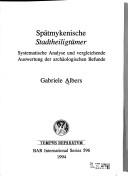
ISBN: 0860547701 Year: 1994 Publisher: Oxford : Tempus Reparatum,
Abstract | Keywords | Export | Availability | Bookmark
 Loading...
Loading...Choose an application
- Reference Manager
- EndNote
- RefWorks (Direct export to RefWorks)
Excavations (Archaeology) --- -Mycenae (Extinct city) --- Mikínai (Extinct city) --- Mukenai (Extinct city) --- Mycena (Extinct city) --- Mycenae (Ancient city) --- Mycenes (Extinct city) --- Greece --- Religion --- Antiquities
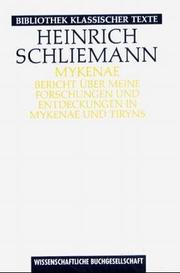
ISBN: 353403290X Year: 1983 Publisher: Darmstadt Wissenschaftliche Buchgesellschaft
Abstract | Keywords | Export | Availability | Bookmark
 Loading...
Loading...Choose an application
- Reference Manager
- EndNote
- RefWorks (Direct export to RefWorks)
Mycenae (Extinct city) --- Tiryns (Extinct city) --- Greece --- Mikínai (Extinct city) --- Mukenai (Extinct city) --- Mycena (Extinct city) --- Mycenae (Ancient city) --- Mycenes (Extinct city) --- Antiquities
Book
ISBN: 1139794868 1108060919 Year: 1901 Publisher: Place of publication not identified : Cambridge : publisher not identified, Cambridge University Press
Abstract | Keywords | Export | Availability | Bookmark
 Loading...
Loading...Choose an application
- Reference Manager
- EndNote
- RefWorks (Direct export to RefWorks)
Sir Arthur John Evans (1851-1941), the pioneer of ancient Cretan archaeology, most famously excavated the ruins of Knossos and uncovered the remains of its Bronze Age Minoan civilisation (as detailed in The Palace of Minos at Knossos, also reissued in this series). In this highly illustrated work, first published in 1901, Evans surveys the recent archaeological evidence from his dig at Knossos as well as from other locations around the Mediterranean. He describes a variety of religious objects and symbols, especially those concerned with sacred stones, pillars and trees, which Evans argues are characteristic of religious worship in the Mycenaean period. He considers in particular the importance of the Cretan double-axe symbol, the labrys, its close link with depictions of bulls and its association with the labyrinth of Knossos. Elsewhere he examines the symbolism of the Lion Gate at Mycenae and finds parallels with similar artefacts found in Crete and Egypt.
Tree worship. --- Cults --- Mycenae (Extinct city) --- Crete (Greece) --- Religion. --- Antiquities. --- Nature worship --- Trees --- Religious aspects --- Mikínai (Extinct city) --- Mukenai (Extinct city) --- Mycena (Extinct city) --- Mycenae (Ancient city) --- Mycenes (Extinct city) --- Greece --- Antiquities
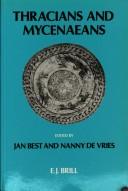
ISBN: 9004088644 9789004088641 Year: 1989 Volume: 11 Publisher: Leiden Brill
Abstract | Keywords | Export | Availability | Bookmark
 Loading...
Loading...Choose an application
- Reference Manager
- EndNote
- RefWorks (Direct export to RefWorks)
Thracians --- Civilization, Mycenaean --- Thraces --- Civilisation mycénienne --- Congresses --- Congrès --- Congresses. --- -Thracians --- -Mycenae (Extinct city) --- -Indo-Europeans --- Mycenaean civilization --- Civilization, Aegean --- -Congresses --- Civilisation mycénienne --- Congrès --- Indo-Europeans --- Mycenae (Extinct city) --- Mikínai (Extinct city) --- Mukenai (Extinct city) --- Mycena (Extinct city) --- Mycenae (Ancient city) --- Mycenes (Extinct city) --- Greece --- Antiquities --- Thracians - Congresses. --- Civilization, Mycenaean - Congresses
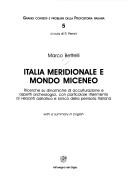
ISBN: 8878142999 Year: 2002 Volume: 5 Publisher: Firenze All'insegna del Giglio
Abstract | Keywords | Export | Availability | Bookmark
 Loading...
Loading...Choose an application
- Reference Manager
- EndNote
- RefWorks (Direct export to RefWorks)
Excavations (Archaeology) --- Pottery, Mycenaean --- Fouilles (Archéologie) --- Céramique mycénienne --- Italy, Southern --- Mezzogiorno (Italie) --- Antiquities --- Antiquités --- Fouilles (Archéologie) --- Céramique mycénienne --- Antiquités --- Pottery, Italic --- Mycenaean pottery --- Pottery --- Italic pottery --- Italy --- Mycenae (Extinct city) --- Meridione (Italy) --- Mezzogiorno (Italy) --- Southern Italy --- Mikínai (Extinct city) --- Mukenai (Extinct city) --- Mycena (Extinct city) --- Mycenae (Ancient city) --- Mycenes (Extinct city) --- Greece --- Relations --- Civilization --- Aegean influences.

ISBN: 0934718849 9780934718844 Year: 1987 Volume: 68 Publisher: Philadelphia (Pa.): University of Pennsylvania. University museum
Abstract | Keywords | Export | Availability | Bookmark
 Loading...
Loading...Choose an application
- Reference Manager
- EndNote
- RefWorks (Direct export to RefWorks)
Architecture, Domestic --- Pottery, Mycenaean --- Mycenae (Extinct city) --- Greece --- Antiquities --- -Pottery, Mycenaean --- -Mycenaean pottery --- Pottery --- Architecture, Rural --- Domestic architecture --- Home design --- Houses --- One-family houses --- Residences --- Rural architecture --- Villas --- Architecture --- Dwellings --- Mikínai (Extinct city) --- Mukenai (Extinct city) --- Mycena (Extinct city) --- Mycenae (Ancient city) --- Mycenes (Extinct city) --- Antiquities. --- -Greece --- Mycenaean pottery --- Architecture, Domestic - Greece - Mycenae (Extinct city) --- Pottery, Mycenaean - Greece - Mycenae (Extinct city) --- Greece - Antiquities
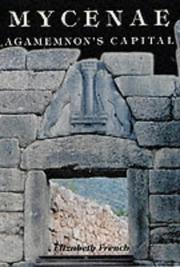
ISBN: 075241951X 9780752419510 Year: 2002 Publisher: Stroud Tempus
Abstract | Keywords | Export | Availability | Bookmark
 Loading...
Loading...Choose an application
- Reference Manager
- EndNote
- RefWorks (Direct export to RefWorks)
Excavations (Archaeology) --- Archaeological digs --- Archaeological excavations --- Digs (Archaeology) --- Excavation sites (Archaeology) --- Ruins --- Sites, Excavation (Archaeology) --- Archaeology --- Mycenae (Extinct city) --- Mikínai (Extinct city) --- Mukenai (Extinct city) --- Mycena (Extinct city) --- Mycenae (Ancient city) --- Mycenes (Extinct city) --- Greece --- Antiquities --- Excavations (Archaeology) - Greece - Mycenae (Extinct city)
Book
ISBN: 9781931534888 9781623034146 1623034140 1931534888 Year: 2017 Volume: 54 Publisher: Philadelphia INSTAP Academic Press
Abstract | Keywords | Export | Availability | Bookmark
 Loading...
Loading...Choose an application
- Reference Manager
- EndNote
- RefWorks (Direct export to RefWorks)
In the English-speaking Western world alone, thousands of men and women begin formal training for Christian ministry each year, or informally, seek to equip themselves for pastoral ministry. Over the past fifty years, the ancient world of virtue ethics has been reimagined as a means of forming people of character and morality today, and in this book, it is used as the framework to understand what we are doing as we form Christian ministers now, and how we might strengthen that formation by more consciously linking the practices of ministry with the person, spirituality, and wisdom of the practitioner. Writing out of the context of a lifetime of pastoral ministry and the oversight of ministers in the Baptist Union of Great Britain, Paul Goodliff explores what pastors do and who they are called to be, using a mixture of theological and pastoral enquiry, reflections upon art and personal story. This book will be of interest to those who are charged with forming the next generation of ministers; but anyone starting out on that journey of formation for ministry will also find this vision of ministry challenging and inspiring.
Mural painting and decoration, Mycenaean --- Greece --- Mycenae (Extinct city) --- Mycenaean mural painting and decoration --- Mikínai (Extinct city) --- Mukenai (Extinct city) --- Mycena (Extinct city) --- Mycenae (Ancient city) --- Mycenes (Extinct city) --- Antiquities --- E-books --- Mural painting and decoration, Mycenaean - Greece - Mycenae (Extinct city) --- Mural painting and decoration, Mycenaean. --- Wandmalerei. --- Mycenae (Extinct city). --- Mycènes (Ville ancienne). --- Mykene.
Book
ISBN: 0511711689 1108016928 Year: 2015 Publisher: Cambridge : Cambridge University Press,
Abstract | Keywords | Export | Availability | Bookmark
 Loading...
Loading...Choose an application
- Reference Manager
- EndNote
- RefWorks (Direct export to RefWorks)
Heinrich Schliemann's account of his archaeological excavations which revealed the existence of the ancient Greek cities of Mycenae and Tiryns.
Excavations (Archaeology) --- Mycenae (Extinct city) --- Tiryns (Extinct city) --- Greece --- Antiquities. --- Archaeological digs --- Archaeological excavations --- Digs (Archaeology) --- Excavation sites (Archaeology) --- Ruins --- Sites, Excavation (Archaeology) --- Archaeology --- Mikínai (Extinct city) --- Mukenai (Extinct city) --- Mycena (Extinct city) --- Mycenae (Ancient city) --- Mycenes (Extinct city) --- Antiquities
Book
ISBN: 1107262267 1108070108 Year: 1891 Publisher: Place of publication not identified : Cambridge : publisher not identified, Cambridge University Press
Abstract | Keywords | Export | Availability | Bookmark
 Loading...
Loading...Choose an application
- Reference Manager
- EndNote
- RefWorks (Direct export to RefWorks)
This overview of the famous and pioneering excavations of Heinrich Schliemann was first published in German in 1889, and in this extended English translation in 1891. The author, Carl Schuchhardt (1859-1943), had wide experience of excavations in both Asia Minor and Europe, and the translator, Eugénie Sellers (1860-1943), was the first female student of the British School at Athens. The book begins with a life of Schliemann, who had died in 1890, and goes on to describe his extraordinary discoveries at Troy and Mycenae, and his work at Tiryns, Ithaca and Orchomenos. It also contains two reports of later work at the mound of Hissarlik, the site of Troy, by Schliemann himself and his assistant Wilhelm Dörpfeld, which had not been included in the German edition. The book is illustrated with many line drawings, and includes the famous photograph of Sophia Schliemann wearing 'the gold of Troy'.
Excavations (Archaeology) --- Schliemann, Heinrich, --- Schliemann, Henry, --- Schlēman, Herrikos, --- Schliemann, Johann Ludwig Heinrich, --- Slēman, Herrikos, --- Schliemann, Henri, --- Shliman, Genrikh, --- Greece --- Mycenae (Extinct city) --- Troy (Extinct city) --- Turkey --- Ilion (Extinct city) --- Ilium (Extinct city) --- Troia (Extinct city) --- Troja (Extinct city) --- Trovaharabesi (Extinct city) --- Troy (Ancient city) --- Mikínai (Extinct city) --- Mukenai (Extinct city) --- Mycena (Extinct city) --- Mycenae (Ancient city) --- Mycenes (Extinct city) --- Antiquities. --- Antiquities
| Listing 1 - 10 of 24 | << page >> |
Sort by
|

 Search
Search Feedback
Feedback About UniCat
About UniCat  Help
Help News
News